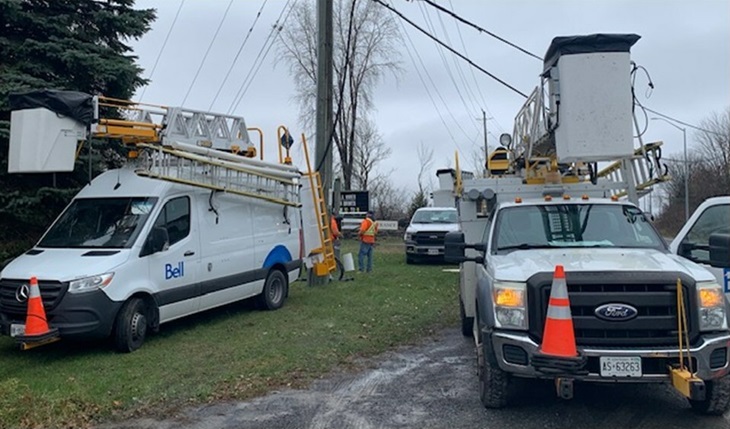
By Ahmad Hathout
Several major telecoms have filed a review and vary application asking the CRTC to adjust its new outage reporting requirements and extend the deadline to implement them because they are currently “impractical or disproportionate” and impose “undue administrative burden” on their businesses.
The CRTC in September gave all telecoms two months to implement the new rules, which require them to report to certain official bodies major outages – newly defined as lasting at least 30 minutes and affecting 600,000 or more user minutes in most cases. Compared to the interim regime from 2023, the new rules lower the reporting threshold from 100,000 users affected over an hour and mandate more disclosure.
Rogers, Bell, Telus, Eastlink, Cogeco, Quebecor, and SaskTel filed a joint application, made public Thursday, that asks the regulator to modify the new rules to make them less burdensome and give them more time to implement the regime they say wasn’t broken during the 18-month interim period.
The current timeline imposed by the commission is “insufficient time” to “develop and deploy the necessary automated systems and/or staff training” as they “greatly” increase the amount of notifications and reports that will be required, require admin staff to sift through what cannot be disclosed publicly, and the two-hour notification window – particularly for outages during the night or early morning hours – require “immediate and disruptive resource allocation,” the application says.
They claim the new rules are contrary to the federal government’s red tape review that is intended to streamline processes and reduce “unnecessary regulatory oversight.”
The telecoms recommend that the commission ditch the user minutes threshold and the 30-minute minimum and instead define major outages as those that affect at least 50,000 users over an hour, lowering by 50,000 the user threshold required of – and overall keeping with – the interim regime.
“By having a simple threshold of impacted users, the regime becomes a lot easier to implement,” the applicants say.
If the CRTC insists on user minutes, then they say it should start with a threshold of 1.8 million user minutes. “A higher user-minute threshold than the U.S. Federal Communications Commission (FCC) mandated 900,000 user minutes is justified due to Canada’s unique geography, more expansive reporting requirements which include reporting for broadband services, and the operational realities faced by smaller and rural providers.”
Despite drawing inspiration from its counterpart south of the border, the telecoms say there are other major differences between the rules imposed by the two: the FCC’s rules don’t apply to broadband services and the reports are presumed confidential, so the obligations are more onerous on Canadian telecoms, the applicants say.
“Regardless of how it compares to the FCC’s regime, the Commission’s new regime will significantly increase the volume and complexity of notifications in comparison to the interim regime, necessitating substantial investments in automated systems, processes, and staff training,” the application reads.
The telecoms illustrate the claimed burden using fibre cuts, which they say they deal with daily. Under the new rules, the telecoms say they “would now have to report these minor events on a daily basis. These lower Commission’s outage reporting thresholds add a disproportionate administrative burden on TSPs at a time when they are urgently focused on repairs to restore service, and communicating with impacted customers as needed.”
The telecoms are asking the CRTC to revert to the interim framework until the regulator establishes its outage notifications and reporting portal and until telecoms “can automate or amend their processes to implement notifications within the portal.”
“Given the Commission’s intention to launch a new portal for reporting, requiring TSPs to amend their processes in this way will require them to implement such improvements twice (i.e. a second time once the portal is launched),” the telecoms say in the application. “This would be counter to the 2023 Policy Direction and recent Red Tape initiatives which require regulation to be efficient, proportionate, and to provide meaningful benefits.”
In the alternative, they are asking the CRTC to maintain the interim regime until nine months after the establishment of new thresholds with the adjustments they recommend above.
The telecoms are also asking that all outage notifications, which includes specific details, be presumed confidential – specifically, the first notification after the event – and that any public disclosure should be limited to post-outage reports.
Those post-outage reports, in addition, should only be mandated for major outages as defined under the interim regime or when explicitly requested by the CRTC, they recommend. “Requiring administratively demanding post-outage reports for every outage is unnecessary and inefficient,” they say.
“More than 18 months elapsed between when the record closed in the proceeding leading up to the Decision and the Decision itself. During that time, the interim regime successfully operated, providing a proven framework for outage reporting and ensuring continuity during this transition period,” the application says.
“As such, the Applicants respectfully submit that it is both unnecessary and unreasonable to provide the industry with only two months to implement the necessary processes to address the newly-established thresholds, especially considering the significant impact that these new thresholds will have on reporting.”
Photo via Bell



